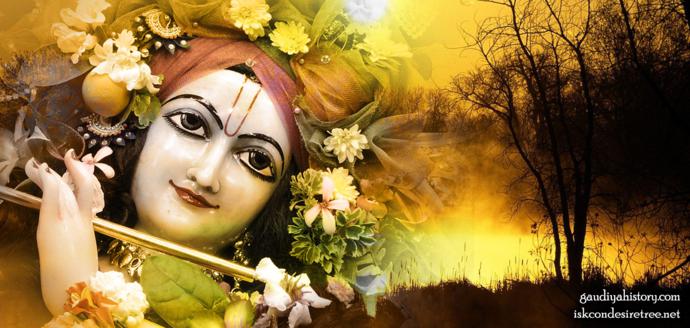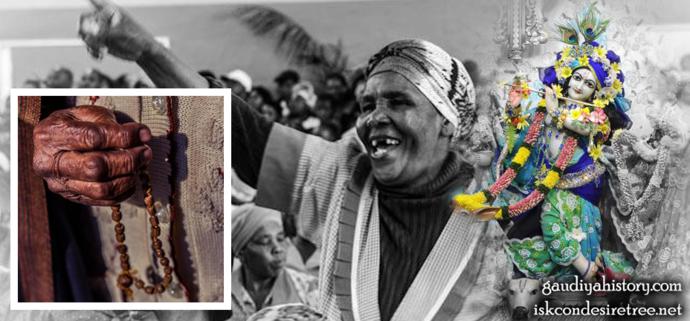kulinagrama-vasi satyaraja, ramananda
yadunatha, purusottama, sankara, vidyananda
(CC. 1.10.80)
Satyaraja, Ramananda, Yadunatha, Purushottama, Shankara and Vidyananda all belonged to the twentieth branch.
He was an inhabitants of the village known as Kulina-grama and a descendent of Shri Gunaraja Khan.
In his past incarnation he was Sukanthi of Vraja.
Kalakantha-devi and Sukantha-devi, the two Gandharva-dancers who appeared in Vrajabhumi, also appeared as Ramananda Vasu and Satyaraja. (GGD 173).
CC Madhya 15.98: The Lord then with great respect extended an invitation to all the inhabitants of Kulina-grama, asking them to come every year and bring silken rope to carry Lord Jagannatha during the Ratha-yatra festival.
Lord Chaitanya explained to the residents of Kulina-grama the various stages of a Devotees advancement (CC. 2.15.104-111, 2.16.69-75)
CC Madhya 15.99: Shri Chaitanya Mahaprabhu then said, "Gunaraja Khan of Kulina-grama compiled a book named Shri Krishna-vijaya, in which there is a sentence revealing the author's ecstatic love of Krishna."
CC Madhya 15.100: Shri Chaitanya Mahaprabhu said, "'Krishna, the son of Nanda Maharaja, is my life and soul.' By this statement I am sold into the hands of the descendants of Gunaraja Khan.

'Krishna, the son of Nanda Maharaja, is my life and soul.' By this statement I am sold into the hands of the descendants of Gunaraja Khan. (In the wallpaper: Shri Gopinath, ISKCON Chowpatty, Mumbai).
CC Madhya 15.101: "To say nothing of you, even a dog living in your village is very dear to Me. What, then, to speak of others?"
CC Madhya 15.102: After this, Ramananda Vasu and Satyaraja Khan both submitted questions at the lotus feet of Shri Chaitanya Mahaprabhu.
CC Madhya 15.103: Satyaraja Khan said, "My dear Lord, being a householder and a materialistic man, I do not know the process of advancing in spiritual life. I therefore submit myself unto Your lotus feet and request You to give me orders."
CC Madhya 15.104: Shri Chaitanya Mahaprabhu replied, "Without cessation continue chanting the Holy Name of Lord Krishna. Whenever possible, serve Him and His Devotees, the Vaishnavas."
CC Madhya 15.105: Upon hearing this, Satyaraja said, "How can I recognize a Vaishnava? Please let me know what a Vaishnava is. What are his common symptoms?"
CC Madhya 15.106: Shri Chaitanya Mahaprabhu replied, "Whoever chants the Holy Name of Krishna just once is worshipable and is the topmost human being.
CC Madhya 15.107: "Simply by chanting the Holy Name of Krishna once, a person is relieved from all the reactions of a sinful life. One can complete the nine processes of devotional service simply by chanting the Holy Name.
CC Madhya 15.108: "One does not have to undergo initiation or execute the activities required before initiation. One simply has to vibrate the Holy Name with his lips. Thus even a man in the lowest class [chanḍala] can be delivered.
CC Madhya 15.109: "By chanting the Holy Name of the Lord, one dissolves his entanglement in material activities. After this, one becomes very much attracted to Krishna, and thus dormant love for Krishna is awakened.
CC Madhya 15.110: "'The Holy Name of Lord Krishna is an attractive feature for many saintly, liberal people. It is the annihilator of all sinful reactions and is so powerful that, save for the dumb who cannot chant it, it is readily available to everyone, including the lowest type of man, the chanḍala. The Holy Name of Krishna is the controller of the opulence of liberation, and it is identical with Krishna. When a person simply chants the Holy Name with his tongue, immediate effects are produced. Chanting the Holy Name does not depend on initiation, pious activities or the puraścarya regulative principles generally observed before initiation. The Holy Name does not wait for any of these activities. It is self-sufficient.'"
CC Madhya 15.111: Shri Chaitanya Mahaprabhu then finally advised, "One who is chanting the Hare Krishna mantra is understood to be a Vaishnava; therefore you should offer all respects to him."
CC Madhya 16.69: As in the previous year, one of the inhabitants of Kulina-grama submitted a petition to the Lord, saying, "My Lord, kindly tell me what my duty is and how I should execute it."
CC Madhya 16.70: The Lord replied, "You should engage yourself in the service of the servants of Krishna and always chant the Holy Name of Krishna. If you do these two things, you will very soon attain shelter at Krishna's lotus feet."
CC Madhya 16.71: The inhabitant of Kulina-grama said, "Please let me know who is actually a Vaishnava and what his symptoms are." Understanding his mind, Shri Chaitanya Mahaprabhu smiled and gave the following reply.

CC Madhya 15.110: "'The Holy Name of Lord Krishna is an attractive feature for many saintly, liberal people. It is the annihilator of all sinful reactions and is so powerful that, save for the dumb who cannot chant it, it is readily available to everyone, including the lowest type of man, the chanḍala. The Holy Name of Krishna is the controller of the opulence of liberation, and it is identical with Krishna. When a person simply chants the Holy Name with his tongue, immediate effects are produced. Chanting the Holy Name does not depend on initiation, pious activities or the puraścarya regulative principles generally observed before initiation. The Holy Name does not wait for any of these activities. It is self-sufficient.'" (In the wallpaper: Sankirtana Yagya in Durban, Africa, Shri Gopinath, ISKCON Chowpatty, Mumbai, a japa mala).
CC Madhya 16.72: "A person who is always chanting the Holy Name of the Lord is to be considered a first-class Vaishnava, and your duty is to serve his lotus feet."
CC Madhya 16.73: The following year, the inhabitants of Kulina-grama again asked the Lord the same question. Hearing this question, Shri Chaitanya Mahaprabhu again taught them about the different types of Vaishnavas.
CC Madhya 16.74: Shri Chaitanya Mahaprabhu said, "A first-class Vaishnava is he whose very presence makes others chant the Holy Name of Krishna."
CC Madhya 16.75: In this way, Shri Chaitanya Mahaprabhu taught the distinctions between different types of Vaishnavas — the Vaishnava, Vaishnavatara and Vaishnavatama. He thus successively explained all the symptoms of a Vaishnava to the inhabitants of Kulina-grama.
Shrila Prabhupada writes in purport of CC Madhya 15.99 about Shri Gunaraja Khan:
Shri Krishna-vijaya is a book of poems considered to be the first poetry book written in Bengal. Shrila Bhaktisiddhanta Saraswati Thakura states that this book was begun in the year 1395 Sakabda (A.D. 1473). After seven years, it was completed (in 1402 Sakabda). This book was written in plain language, and even half-educated Bengalis and women could read it very clearly. Even ordinary men with little knowledge of the alphabet could read this book and understand it. Its language is not very ornamental, and sometimes the poetry is not very sweet to hear. Although according to the sonnet style each line should contain fourteen syllables, there are sometimes sixteen, twelve or thirteen syllables in his verse. Many words used in those days could be understood only by local inhabitants, yet this book is still so popular that no bookstore is complete without it. It is very valuable for those who are interested in advancing in Krishna consciousness.
Shri Gunaraja Khan was one of the topmost Vaishnavas, and he translated the Tenth and Eleventh Cantos of Shrimad-Bhagavatam for the understanding of the common man. The book Shri Krishna-vijaya was highly praised by Shri Chaitanya Mahaprabhu, and it is very valuable for all Vaishnavas. Shrila Bhaktisiddhanta Saraswati Thakura gives a genealogical table and family history of Gunaraja Khan. When a Bengali emperor named Adisura first came from Kanyakubja, or Kanauj, he brought with him five brahmanas and five kayasthas. Since the king is supposed to be accompanied by his associates, the brahmanas accompanied the King to help him in higher spiritual matters. The kayasthas were to render other services. In the northern Indian high country, the kayasthas are accepted as shudras, but in Bengal the kayasthas are considered among the higher castes. It is a fact that the kayasthas came to Bengal from northern India, specifically from Kanyakubja, or Kanauj. Shrila Bhaktisiddhanta Saraswati Thakura says that the kayasthas who came from Kanyakubja were high-class men. Of them, Dasharatha Vasu was a great personality, and the thirteenth generation of his family included Gunaraja Khan.
His real name was Maladhara Vasu, but the title Khan was given to him by the Emperor of Bengal. Thus he became known as Gunaraja Khan. Bhaktisiddhanta Saraswati Thakura gives the following genealogical table of Gunaraja Khan: (1) Dasharatha Vasu; (2) Kushala; (3) Subhashankara; (4) Hamsa; (5) Saktirama (Baganda), Muktirama (Mainagara) and Alankara (Bangaja); (6) Damodara; (7) Anantarama; (8) Guninayaka and Vinanayaka. The twelfth generation included Bhagiratha, and the thirteenth Maladhara Vasu, or Gunaraja Khan. Shri Gunaraja Khan had fourteen sons, of whom the second son, Lakshminatha Vasu, received the title Satyaraja Khan. His son was Shri Ramananda Vasu; therefore Ramananda Vasu belonged to the fifteenth generation. Gunaraja Khan was a very well known and wealthy man. His palace, fort and temples are still existing, and from these we can deduce that the opulence of Gunaraja Khan was certainly very great. Shri Gunaraja Khan never cared for the artificial aristocracy introduced by Ballal Sena.

A first-class Vaishnava is he whose very presence makes others chant the Holy Name of Krishna. (In the image: Shrila Prabhupada leading kirtan, Tompkins Park, USA).



